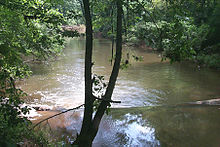262:
205:
134:, and Sissipahaw were different tribes or bands of the same tribe. This distinction became moot as the tribes merged with one another as their numbers decreased. Although they merged into remnants of other tribes and the larger Catawba, their Siouan dialect survived as late as 1743 among the Eno. They resisted Catawba assimilation the longest.
24:
105:
and other structures out of interwoven saplings and sticks; these were covered in mud as opposed to the bark typically used by other nearby tribes. They were described as being similar to traditional dwellings of the
142:
Although their origins are uncertain, the
Shakori were among the Siouan-speaking tribes found in the Piedmont area of numerous southern states. They are believed to have joined against the English colonists in the
337:
151:. On February 27, 1714, the Virginia colony reached an agreement. The remnants of the Saponi, Tottero, Occaneechi, Keyauwee, Enoke (or Eno), and Shakori formally coalesced, becoming
342:
332:
101:
Although little is known about the
Shakori, at the time of contact, they were not noted as being noticeably different from the surrounding tribes. They made their
39:
246:
303:
126:
The
Shakori were associated with other Siouan tribes of the Piedmont, such as the Sissipahaw and Eno, and they all are believed to have spoken the same
322:
212:
239:
17:
296:
347:
232:
82:
28:
289:
147:. It is likely that by this time they were already confederated or merged with remnants of other tribes, such as the
327:
27:
The
Shakori, and the related Eno, lived along the banks of the river in the vicinity of modern-day
90:
114:. In the center of the village, men often played a slinging stone game, probably similar to the
273:
216:
78:
66:
156:
127:
269:
261:
59:
316:
152:
131:
47:
144:
51:
86:
111:
204:
115:
102:
23:
148:
107:
43:
77:
who, although smaller in stature and number, were able to evade the
159:
and other regional groups, but the
Shakori are extinct as a tribe.
155:. Descendants with partial Shakori ancestry are likely among the
22:
46:
people, closely allied with other nearby tribes such as the
277:
220:
177:The Handbook of American Indians North of Mexico.
81:. Their villages were located around what is now
58:they may be the same as the Sugaree, as both are
338:Indigenous peoples of the Southeastern Woodlands
40:indigenous people of the Southeastern Woodlands
297:
240:
192:Washington, D.C.: Government Printing Office.
179:Washington, D.C.: Government Printing Office.
8:
304:
290:
247:
233:
343:Indigenous peoples of North America stubs
118:played by tribes further south and west.
333:Native American tribes in North Carolina
168:
130:. Scholars debate whether the Shakori,
54:. As their name is also recorded as
7:
258:
256:
201:
199:
213:Indigenous peoples of North America
276:. You can help Knowledge (XXG) by
219:. You can help Knowledge (XXG) by
14:
18:Shakori Hills Grassroots Festival
260:
203:
323:Extinct Native American peoples
190:The Siouan Tribes of the East.
65:Yardley in 1654 wrote about a
1:
211:This article relating to the
83:Hillsborough, North Carolina
42:. They were thought to be a
29:Hillsborough, North Carolina
364:
255:
198:
15:
69:guide's accounts of the
85:along the banks of the
272:–related article is a
31:
16:For the festival, see
175:Hodge, F. W. (1910).
26:
348:North Carolina stubs
188:Mooney, J. (1894).
153:"The Saponi Nation"
32:
285:
284:
228:
227:
355:
306:
299:
292:
264:
257:
249:
242:
235:
207:
200:
193:
186:
180:
173:
363:
362:
358:
357:
356:
354:
353:
352:
313:
312:
311:
310:
254:
253:
197:
196:
187:
183:
174:
170:
165:
140:
128:Siouan language
124:
99:
21:
12:
11:
5:
361:
359:
351:
350:
345:
340:
335:
330:
328:Siouan peoples
325:
315:
314:
309:
308:
301:
294:
286:
283:
282:
270:North Carolina
265:
252:
251:
244:
237:
229:
226:
225:
208:
195:
194:
181:
167:
166:
164:
161:
139:
136:
123:
120:
98:
95:
60:Catawba people
13:
10:
9:
6:
4:
3:
2:
360:
349:
346:
344:
341:
339:
336:
334:
331:
329:
326:
324:
321:
320:
318:
307:
302:
300:
295:
293:
288:
287:
281:
279:
275:
271:
266:
263:
259:
250:
245:
243:
238:
236:
231:
230:
224:
222:
218:
214:
209:
206:
202:
191:
185:
182:
178:
172:
169:
162:
160:
158:
154:
150:
146:
137:
135:
133:
129:
121:
119:
117:
113:
109:
104:
96:
94:
92:
88:
84:
80:
76:
72:
68:
63:
61:
57:
53:
49:
45:
41:
37:
30:
25:
19:
278:expanding it
267:
221:expanding it
210:
189:
184:
176:
171:
141:
125:
100:
74:
73:people from
70:
64:
55:
35:
33:
145:Yamasee War
317:Categories
56:Shaccoree,
52:Sissipahaw
79:Tuscarora
67:Tuscarora
122:Language
112:Arkansas
93:rivers.
50:and the
38:were an
157:Catawba
138:History
116:chunkey
103:wigwams
97:Culture
75:Haynoke
71:Cacores
36:Shakori
149:Saponi
108:Quapaw
91:Shocco
44:Siouan
268:This
215:is a
163:Notes
110:from
274:stub
217:stub
89:and
34:The
132:Eno
87:Eno
48:Eno
319::
62:.
305:e
298:t
291:v
280:.
248:e
241:t
234:v
223:.
20:.
Text is available under the Creative Commons Attribution-ShareAlike License. Additional terms may apply.
